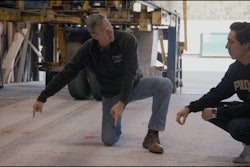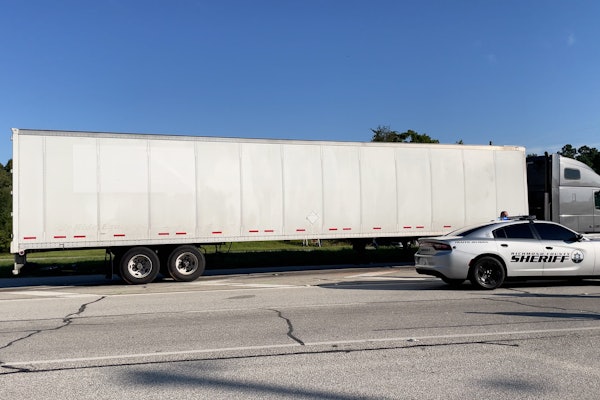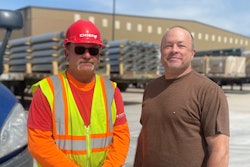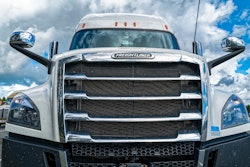Truck and engine manufacturers have been challenged by various regulations to do the seemingly impossible: remove emissions from more than 3 million commercial trucks in less than three decades. No one's been given a road map, but everyone's been given deadlines and a complex ruleset that Lars Stenqvist, Volvo Group executive vice president of Trucks Technology, calls "exciting."
“I’m in the industry of making the impossible possible," he said. "That’s why we have engineers.”
Stenqvist's optimism is tempered with frustration with "trigger happy" lawmakers hellbent on banning potential solutions rather than simply telling engineers what they want to achieve.
“I have 15,000 engineers [at Volvo Group],” he said. “Tell them what you want to achieve, but don’t ban technologies... there is no silver bullet to decarbonize transportation.”
Stenqvist sees a varied approach to driveline propulsion yielding the best and most desired results, and letting the segments determine what solutions work best in their applications. Stenqvist, too, said his own opinions on how and where batteries and hydrogen have changed over the last several years, and how solutions like hydrogen combustion engines – which produces no carbon dioxide but does have nitrogen oxide emissions – should also be in play.
“We should be be able to determine where to use it, and where should we not use it," he said.
Fossil-free from end-to-end
A green energy transition is well underway across practically every business segment, even at the utility level. In 2025, renewables will surpass coal-fired electricity generation and wind will surpass nuclear, according to the International Energy Agency. The following year, solar will pass nuclear and by 2028, solar will pass solar wind electricity generation.
As a consumer of electricity and a manufacturing business, Volvo's fossil-free approach doesn't extend solely to the fuel-type of its trucks.
Lars Mårtensson, director of environment and innovation at Volvo Trucks, said that the environmental impact of manufacturing an electric truck is greater than that of manufacturing diesel, thanks mostly to the batteries and electronics.
Volvo is taking its fossil-free philosophy as far down the assembly line as it can go by sourcing fossil-free steel for use in assembly.
Volvo Group and Swedish-American steel producer SSAB in October 2021 unveiled the world’s first vehicle created from fossil-free steel: a mining load carrier. The following May, Volvo Trucks introduced fossil-free steel into Volvo FH, Volvo FM and Volvo FMX models. Volvo Construction Equipment in June 2022 became the first manufacturer to ever deliver a construction machine made with fossil-free steel to a customer.
“All steel manufacturers need to go this way,” Stenqvist said, noting Volvo buys all the fossil-free steel – made with hydrogen versus iron ore – that it can find, and that from a strength and molecular standpoint it's the same as raw steel.
Clean energy stakeholders may not agree on the total cost to convert to zero emissions but practically all concede that it's going to be expensive. Stenqvist noted rather than simply heaping expenses on fleets and companies trying to do their part, "to get the real transformation happening, society needs to put the true price on carbon," he said. "Meaning fossil-based fuels need to pay for the damage they are creating. Very few companies can do it solely to save the planet. It will be accelerated if we put the right price on carbon."
The transformation to clean trucking, said Jan Hjelmgren, head of product management and quality for Volvo Trucks, is "the biggest change ever. We need to continue to transport stuff, and we need to transport more, but we need to do it differently."
'Step-by-step' approach
Combustion engines, battery electric and fuel cell electric will each play some measure of a role in getting to zero on-highway emissions, but Hjelmgren noted, "there is only one target and that is the full decarbonization of transport."
In the interim period between now and the zero emission future, Hjelmgren said it will be important to make incremental gains with fossil-based fuels and those will come through gains in fuel economy, light weighting and aerodynamics.
"Our way to decarbonize is step-by-step," he said.
Volvo Group and Westport last summer established a joint venture to accelerate the commercialization of Westport’s High Pressure Direct Injection (HPDI) fuel system technology for long-haul and off-road applications. Natural gas, Hjelmgren added, is a step "that can be done today," and that HPDI can play a role in finding a role for hydrogen combustion engines.
"Combustion engines running on renewable fuel isn't something that's going to end at a certain time," Hjelmgren said.
ICE technologies, good for operators that need a lot of power, are also mature and proven.
"Hydrogen combustion engine isn't a new technology. It's been around for a long time," said Staffan Lundgren Volvo Trucks senior technical advisor. "Hydrogen ICE and fuel cell both have a place on the market."
While combustion engines have a head start in technology validation, hydrogen combustion faces the same infrastructure challenges as fuel cell, said Helena Alsiö, Volvo Trucks powertrain product management.
Volvo has placed 3,000-plus electric trucks in customer fleets in 45 countries, roughly 500 of which are VNR Electrics in North America. The company's electric trucks have covered roughly 22 million miles. "It means we're learning a lot," Hjelmgren said. Among those learnings, he said, is that range anxiety in many cases does not align with reality. "We still see a lot of customers are not using all the battery capacity that they're actually carrying. You can actually do with a little bit less."
Investing in the future
Hjelmgren said Volvo Groups' level of investment in research and development is at record levels, and Stenqvist noted that this year Volvo will spend more money than ever on combustion engines thanks to upcoming legislations, while also focusing on renewable fuels and zero emissions.
Volvo Group is in the process of erecting a 400-acre battery plant in Mariestad, Sweden. Production is expected to begin in 2028 with ramp-up to full-scale production by 2030. The ability to produce its own batteries helps accelerate Volvo's goal of a fossil-free value chain, said Fredrik Agelén, chief program manager for the Volvo Battery Plant, adding that the battery plant will be fossil-free effective the day it opens.
Stateside, Volvo Group acquired Proterra Inc., and Proterra Operating Company out of Chapter 11 bankruptcy earlier this year, including a development center for battery modules and packs in California and an assembly facility in South Carolina.
Peter Granqvist, senior vice president Volvo Group Electromobility Technology, said the acquisition closes a gap in Volvo's industrial capabilities and "keeping our number one position in being early out in electromobility... accelerating our battery electric offering in the U.S."
Granqvist said Volvo was drawn to Proterra because its prior technologies were designed for heavy trucks and buses and weren't scaled from passenger cars. Proterra will have Volvo as a customer and remain a separate business entity, selling its technologies to other customers as well.
Overcoming infrastructure challenges
Volvo Group isn't waiting around for any kind of infrastructure to scale itself. To alleviate some of the early hydrogen infrastructure pains, Volvo is looking into mobile hydrogen fueling stations, although that is mostly focused on off-road applications.
Volvo Energy, Volvo Group's newest business unit, was created to accelerating the company's electrification and sustainability journey through Battery Energy Storage System (BESS), a specialized unit designed to store and release electrical energy, and on-site and en-route charging solutions.
Pilot Company and Volvo Group in 2022 agreed to jointly develop a high-performance charging network open to all battery-electric Class 8 trucks. Chargers will be located at select Pilot and Flying J travel centers, which are ideally positioned along transportation corridors and are well-equipped to serve professional drivers.
To maximize zero emissions, the energy that turns the wheels – whatever it is – has to be green, too. Mårtensson noted that unclean production of clean fuels, even electricity, could actually be "many times worse than using diesel."
More than 40% of the diesel consumption in Europe can be replaced with bio-CNG and bio-LNG, according to Mårtensson. There is has been a shift away from bio-diesel to renewable diesel because bio-diesel uses food stock. Renewable diesel, a drop in fuel comparable to fossil-based diesel, is produced from waste. The Scandinavian grid is powered by roughly 98% fossil-free energy, Agelén added.











